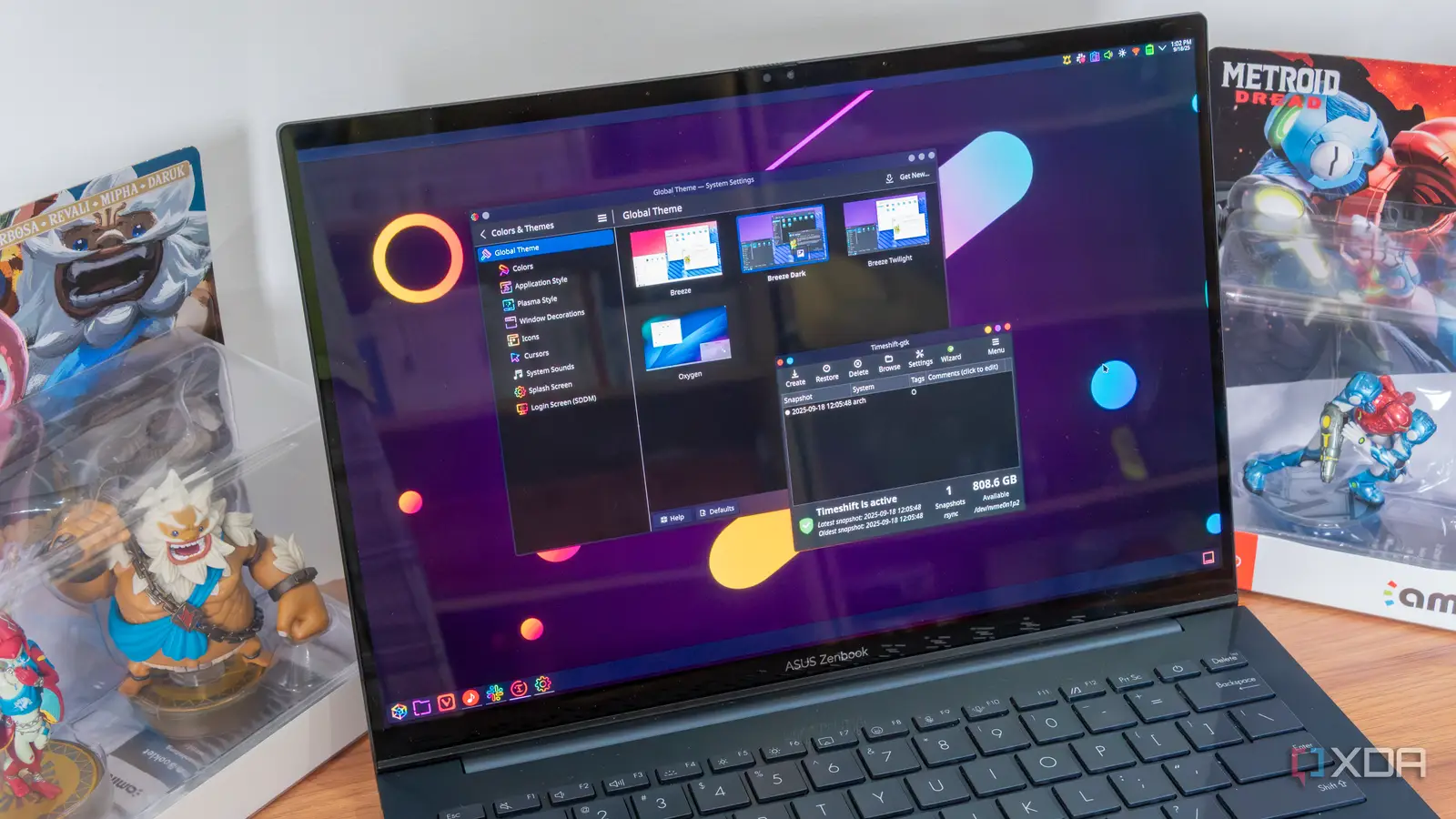
Windows has long been the dominant force when it comes to desktop operating systems, and there really isn’t much room for debate there. It’s got a massive lead on both macOS and Linux, and it’s so ingrained in our society that a lot of Windows users have never known anything else. After all, ignorance is bliss, and Windows 11 works well enough if you don’t know about the alternatives.
But that’s just the thing: if you do learn about the alternatives, then it quickly becomes apparent that there are some big benefits to a platform like Linux that Windows users have never really known about. Let me tell you about some of the things you’ve been missing out on if you’ve spent your whole life on Windows.
Drivers without bloat
Okay, this one varies a bit
It would be unfair to say that Windows 11 doesn’t have any drivers without bloated software, but there are some particular cases where driver bloat is a big problem on Windows, and none of that exists on Linux. Take, for example, Nvidia’s graphics drivers. You can typically only install them with the Nvidia installer, and that tries to force things like the Nvidia app on you with a bunch of things you don’t really need (but hey, it’s an upgrade over the old GeForce Experience app). AMD also provides with its software suite for managing its drivers and settings, and Intel does the same thing.
Not to mention the driver updaters a lot of companies include for their Windows laptops, which can also be bloated in their own right. On Linux, none of this is forced onto users. All the drivers are just installed with the command line, and they just work. Most of the time, fully functional drivers are already included with the Linux kernel, so you probably don’t need any updates after installing the operating system itself, unlike on Windows where you often need to check Windows Update after the fact to get a proper experience. It’s a much more streamlined experience.
Install what you want, when you want
Complaining about Windows updates is among the favorite pastimes of Windows users, and it’s generally for good reason. Windows 11 automatically and forcibly installs updates as they come out, and to be fair, there is often a good reason for it, as they address potential security and stability issues. But it’s still very annoying for users to be constantly notified of updates that are pending a restart, or in some cases, have the computer restart by itself when you need it for work.
For the most part, this is not an issue on Linux at all. Most Linux distros only install updates when you actively seek them (though some may notify you when updates are available), and in many cases, you’re not forced to restart your computer. You can keep using it completely fine, and when you restart, it will apply the updates at the next boot. What’s more, there usually isn’t an extended waiting period after installing an update, either. Linux just loads with all the new files instead of the old ones, so you’re good to go.
Desktop environments
Choose your own flavor
It’s very easy to identify any version of Windows because whenever a new one comes out, it has a new desktop design, and that design is the same for everyone. That’s not the case for Linux, though, because of a concept known as desktop environments. Whatever operating system is underneath, Linux can be customized with all kinds of different desktop environments that look and feel radically different in a wide range of ways.
For example, Ubuntu is a Linux distro that uses the GNOME desktop environment, with some paradigms like a full-screen app list, a dock aligned to the side, and a bar along the top with access to quick settings and workspaces. Then you can use something like Linux Mint, which is actually based on Ubuntu, but uses the Cinnamon desktop environment, with a more “traditional” taskbar and launcher. Bazzite is a more recent and popular choice for gaming, and outside of the SteamOS-like environment, it uses a desktop environment called KDE Plasma. And then you have distros like Arch Linux that don’t ship with a single desktop environment and let you choose your favorite out of the box, whether it’s one of the options I just mentioned or another like Xfce.
Your experience on Linux isn’t tied down to a specific version of Linux itself. You can have radically different experiences underpinned by the same Linux kernel. Windows has some attempts at creating a desktop environment like Seelen UI, but they’re nowhere near as in-depth or consistent as what you can get on Linux.
Proper customization options
You can go even further
Desktop environments are one of the lower layers of customization on Linux, but they’re also just the beginning. Each desktop environment offers its own approach to customization, letting you do all kinds of things that often feel more hacky on Windows. For example, GNOME has extensions that let you change the shell almost completely. You can see it in action in a distro like AnduinOS, which adds a ton of Windows-like elements through GNOME extensions, in case you want a more familiar experience.
KDE is heavily customizable by adding docks to the edges of the screen and using add-ons to display more information and features in them, with Cinnamon also having a similar approach. But you can also install KDE themes to completely change the look and feel of windows, apps, and icons. I customized my KDE Plasma desktop with a set of very colorful icons and some translucency effects that make the desktop look just how I want it. On some distros, you can also use the Kvantum engine to enable even deeper customization (as I did), and it works great. It can still feel a bit hacky when you have to install an extra app, but it feels more native than most customization options on Windows.
And there’s even more you can change in terms of settings and everything else. You can get much more detailed with some settings, like setting screen timeouts for different power modes, or limiting the battery charge (on KDE, at least).
Live booting
Test operating systems and troubleshoot easily
One of the great things about Linux is the ability of most distros to run off a USB drive for a quick testing or troubleshooting session. It’s very easy to keep a Linux distro on hand to test on any computer, or, if you have something like Ventoy, you can keep a handful of them on you and use them to quickly test a distro on a specific computer, or even show someone what Linux might look like on their computer without any impact to their data. You could even use a tool like GParted to make changes to the disk on your PC when the built-in disk management tools on Windows aren’t reliable.
Windows did have a feature like this called Windows To Go, but it’s been discontinued for a while, and it’s only kept alive by a tool like Rufus. Even then, it’s meant to be a full, portable installation of Windows, not a typical live boot where you start fresh each time, and you don’t need a very large drive. Windows To Go requires as much space on your USB drive as it would on a proper HDD or SSD. Plus, you need proper drivers for each device you’ll use it on, and very often, Windows doesn’t include drivers that work well on every device, so it will require updates for every machine you use it on.
Easy restore points
Small in size, easy to use
Windows comes with solutions for restoring your system, yes, but restore points on Windows are quite large and each snapshot takes a lot more space, which is limited. Linux has solutions like Timeshift that make backups very easy. Snapshots of your system are taken regularly, and any files that are the same between snapshots are only saved once, so you don’t take up any more space than you need. You could reasonably have daily snapshots with minimal impact on your storage capacity.
While these snapshots don’t back up your personal data, they can get you back to a working state if you’ve found yourself with a broken system after installing an update or trying to change a setting. They’re much easier to use and apply, and they come at a very low storage cost, so it’s highly recommended that you use them.
Linux has so many benefits
I know Linux can be a bit scary to try, but once you get to know its benefits, it can make for a much more pleasant experience overall. Windows has its own benefits, but I find Linux to be far more interesting overall, between its customization options and how easily it can be tested.



